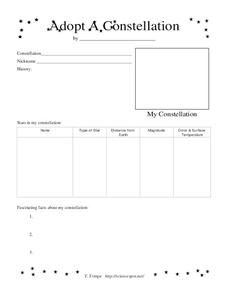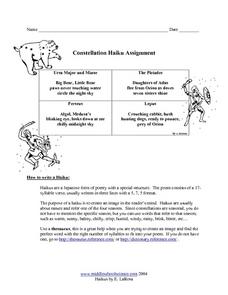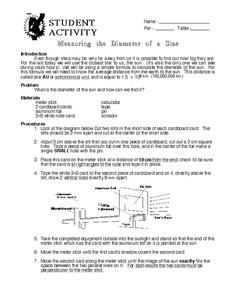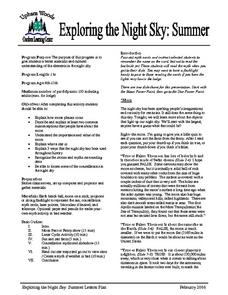Curated OER
Where Did All the Stars Go?
For this brightness of stars worksheet, students solve 4 problems given a unit of measurement of cents/second for brightness. Students find cents collected in timed exposures, they find brightness of stars and they determine visibility...
Curated OER
Measuring Star Temperatures
In this measuring star temperatures, students find the temperature of a star using Planck's curve and the Wein Displacement law. Students also find the peak wavelengths for given stars using Planck's curve.
Curated OER
Stars in Your Eyes
In this solar system worksheet, students answer 20 short answer questions about the stars, the planets, the sun and moon, meteorites and constellations.
Curated OER
Adopt a Constellation
Students adopt a constellation and find detailed information about their constellation. In this constellation lesson plan, students use the web to find information about a constellation of their choice. They identify the history of the...
Curated OER
Star Types-Color and Surface Temperature
In this types of stars worksheet, students complete a table with the color and star type for 17 stars. They are given their luminosity and surface temperature along with a chart that has characteristics of stars to use as reference.
Curated OER
Introduction to the Planisphere
In this planisphere worksheet, students use a planisphere to locate stars and constellations for particular times and dates. Students use the planisphere to answer specific questions about stars and constellations that are rising and...
Curated OER
Star Light, Star Bright: Exploring How Stars are Classified
In this star classification activity, middle schoolers are given laminated star charts to make observations about stars. They work in groups to classify groups of stars based on different characteristics. For each group of stars they...
Curated OER
Constellation Haiku Assignment
In this constellation haiku worksheet, students create a poem with a 17-syllable verse that paints a picture about a constellation. They use words that refer to the seasons since constellations are seasonal. Students can use a thesaurus...
Curated OER
Mapping Constellations
Students become familiar with constellations. In this space science lesson, the teacher introduces constellations by showing students the star patterns and reading myths. Students, observe the stars nightly, then choose one constellation...
Curated OER
Stars
In this stars worksheet, learners determine if 15 statements about stars, constellations, Polaris, light years and the position of the stars are true or false. If they are false, students change the italicized word in the sentence to...
Curated OER
Integrating Space Science-Our Changing Universe
For this universe worksheet, students read about the big bang theory and the evolution of the stars from the elements. Students answer four critical thinking questions about the beginnings of our universe.
Curated OER
Scavenger Hunt: Who am I?
For this solar system worksheet, students use an on line source to find the names of the people who discovered the planets, comets, asteroids, black holes and the idea of the big bang theory.
Curated OER
Star Wheel Worksheet
In this star worksheet, students use a star wheel to observe the location of constellations and the North Star. They answer questions about the changes in the location of the stars and observe their rotation in comparison to earth.
Curated OER
The Spectroscope Lab
In this spectroscope worksheet, students observe fluorescent and incandescent lights through the spectroscope. They record their observations and observe spectra of elements. They answer questions about the chemical make-up of stars...
Curated OER
Constellation Tracking
In this constellation worksheet, students pick a constellation to track over time. They measure its altitude and azimuth at least three times. They make an experimental design for their research and plot their data.
Curated OER
Comparing Planets in our Solar System to Stars
In this solar system worksheet, students complete a Venn diagram by comparing and contrasting the characteristics of planets and stars.
Curated OER
Galaxies and Stars Scavenger Hunt
In this space worksheet, learners identify and describe what auroras are in the sky and why they are made up of different colors. Then they explain why stars are born and what happens to them as they get older. Students also name which...
Curated OER
Adopt A Constellation
In this space science worksheet, students discover and write the name of their favorite constellation. Then they describe the history of it and draw a diagram, labeling the major stars and providing lines to show its shape.
Curated OER
Constellations
In this constellations activity, students define and discuss forty key terms associated with constellations and circle each one in a word search puzzle.
Curated OER
Measuring The Diameter of a Star
In this space science learning exercise, students find the correct measurements using the tools provided in this lab experiment. The second page is used to record data.
Curated OER
Observing The Sky
In this space science worksheet, students find the words that are related to the observations made of constellations and other related puzzles.
Curated OER
How Do Astronomers Measure Distances to Stars?
In this astronomy activity, students participate in an activity using the parallax effect to measure star distances. They record their information in a data table then complete 5 fill in the blank conclusion questions.
Curated OER
The Hertzsprung-Russell Diagram
In this astronomy worksheet, students use a Hertzsprung-Russell diagram to examine the relationship between the average temperatures of stars and their absolute magnitude. After viewing the diagram, they complete 10 short answer questions.
Curated OER
Exploring the Night Sky: Summer
Learners explain how moon phases occur. They describe and explain at least two common misconceptions that people have about the moon. Students explain what a star is. They explain 3 ways that the night sky has been used throughout history.























